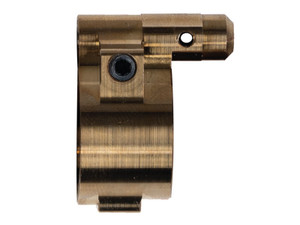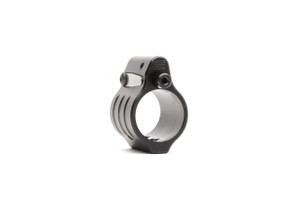
The suppressed gas ports on conventional plates are .004″ apart offering two sizes, and the low back pressure plates have 2 sizes .008″ apart with the exception of the .300BLK plate.
Note: The .300BLK low back pressure plates have to be set to normal to allow rifles to function with subsonic ammunition and a suppressor. The use of a low back pressure suppressor with a .300BLK AR-15 will likely be incompatible with semi-automatic function of the rifle with subsonic ammunition, as most guns are tuned to run subsonic only when a conventional back pressure suppressor is affixed to the muzzle of the barrel.
Griffin to-date has developed a total of 9 plates to address the vast majority of setups in the hands of end users today. Additionally, we offer 2 pre-drilled “Drill Your Own” plates with .033″ starting holes to reduce drill breakage, that allow the user to determine and drill their preferred hole sizes for their desired results. One of the pre-drilled options has the two .096″ normal (unsuppressed) operation holes pre-drilled, and the other has all four holes spot-chamfered to .108″ with .033″ pre-drilled starter holes only, allowing end users to customize all four port sizes. Which plate you should purchase is a factor of your host firearm’s gas system length, its caliber, and the type of suppressor being used (conventional or low back pressure/high flow).
Don’t know which regulator plate to pick? Our knowledgeable CS team is standing by and will be happy to guide you through choosing the proper regulator plate for your setup. Click Here to contact Customer Service.
Conventional Suppressors vs. Low Back Pressure Suppressors
Conventional suppressors can be defined as suppressors that don’t have printed channels or printed gas bypass features to increase gas evacuation speed. Low Back Pressure suppressors are hallmarked by extensive baffle-to-baffle porting, complex internal geometries, and vented end caps. Conventional suppressors are designed to offer higher muzzle sound suppression, and often are made using numerous stamped or CNC-manufactured components. They typically are not printed, although a more conventionally performing suppressor can also be printed. Ejection patterns are another way to identify low back pressure suppressors. Typically, conventional suppressors change the ejection pattern of an AR-15 from 4:30 to around 1-2 o-clock, whereas low back pressure suppressors have less effect to alter spent case ejection patterns from unsuppressed normal operation.
Griffin Suppressor Recommendations: All Griffin Suppressors except the Optimus® 6 & 7 should utilize the “Conventional” plates. Optimus® 6 & 7 Suppressors should be paired with a “Low Back Pressure” plate.
Available Regulator Plates
- Rifle-Length Gas System | 5.56mm | Conventional Suppressor
- Rifle-Length Gas System | 5.56mm | Low Back Pressure Suppressor
- Mid-Length Gas System | 5.56mm | Conventional Suppressor
- Mid-Length Gas System | 5.56mm | Low Back Pressure Suppressor
- Carbine-Length Gas System | 5.56mm | Conventional Suppressor
- Carbine-Length Gas System | 5.56mm | Low Back Pressure Suppressor
- Pistol-Length Gas System | 5.56mm | Conventional Suppressor
- Pistol-Length Gas System | 5.56mm | Low Back Pressure Suppressor
- Pistol-Length Gas System | .300 BLK | Conventional Suppressor (This has the same dimensions as the Carbine-Length | 5.56mm | Conventional Suppressor regulator plate, and are thus the same product)
- Pistol-Length Gas System | .300 BLK | Low Back Pressure Suppressor
- Drill Your Own (4x Holes – All .033″ diameter for subsequent drilling to final size)
- Drill Your Own (2x .033″ Holes for subsequent drilling to final suppressed size | 2x .096″ Holes for normal/unsuppressed use)
Drill Your Own DISCLAIMER: This operation should be performed by a professional gunsmith with a high-level understanding of AR-15 gassing and proper port sizes. Customers purchasing a Drill Your Own Plate assume all responsibility for the performance of that product once it has been altered. Griffin is not responsible for improperly drilled plates for any reason, and will not accept returns or exchanges on these items. We recommend securing the plate in a vise with the U shaped notches for bullet tip adjustment in contact with each jaw of the vise. We recommend using high speed steel or cobalt drill bits held on axis of the pre-drilled holes, with oil coolant, and slow drill RPMS with light pressure, to ensure positive results.









